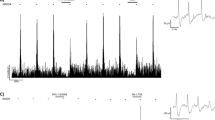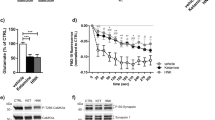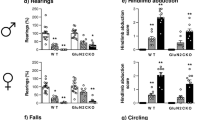Abstract
NMDA glutamate receptor antagonists are used in clinical anesthesia, and are being developed as therapeutic agents for preventing neurodegeneration in stroke, epilepsy, and brain trauma. However, the ability of these agents to produce neurotoxicity in adult rats and psychosis in adult humans compromises their clinical usefulness. In addition, an NMDA receptor hypofunction (NRHypo) state might play a role in neurodegenerative and psychotic disorders, like Alzheimer's disease and schizophrenia. Thus, understanding the mechanism underlying NRHypo-induced neurotoxicity and psychosis could have significant clinically relevant benefits. NRHypo neurotoxicity can be prevented by several classes of agents (eg antimuscarinics, non-NMDA glutamate antagonists, and α2 adrenergic agonists) suggesting that the mechanism of neurotoxicity is complex. In the present study a series of experiments was undertaken to more definitively define the receptors and complex neural circuitry underlying NRHypo neurotoxicity. Injection of either the muscarinic antagonist scopolamine or the non-NMDA antagonist NBQX directly into the cortex prevented NRHypo neurotoxicity. Clonidine, an α2 adrenergic agonist, protected against the neurotoxicity when injected into the basal forebrain. The combined injection of muscarinic and non-NMDA Glu agonists reproduced the neurotoxic reaction. Based on these and other results, we conclude that the mechanism is indirect, and involves a complex network disturbance, whereby blockade of NMDA receptors on inhibitory neurons in multiple subcortical brain regions, disinhibits glutamatergic and cholinergic projections to the cerebral cortex. Simultaneous excitotoxic stimulation of muscarinic (m3) and glutamate (AMPA/kainate) receptors on cerebrocortical neurons appears to be the proximal mechanism by which the neurotoxic and psychotomimetic effects of NRHypo are mediated.
This is a preview of subscription content, access via your institution
Access options
Subscribe to this journal
Receive 12 print issues and online access
$259.00 per year
only $21.58 per issue
Buy this article
- Purchase on Springer Link
- Instant access to full article PDF
Prices may be subject to local taxes which are calculated during checkout







Similar content being viewed by others
References
Domino EF, Luby ED . Abnormal mental states induced by phencyclidine as a model of schizophrenia. In: Domino EF (ed) PCP (Phenyclidine): Historical and Current Perspectives NPP Books: Ann Arbor 1981 401–418
Javitt DC, Zukin SR . Recent advances in the phenyclidine model of schizophrenia Am J Psychiatry 1991 148: 1301–1308
Kristensen JD, Svensson B, Gordh T . The NMDA receptor-antagonist CPP abolishes neurogenic ‘wind-up pain’ after intrathecal administration in humans Pain 1992 51: 249–253
Herrling P . D-CPPene (SDZ EAA 494), a competitive NMDA antagonist. Results from animal models and first results in humans Neuropsychopharmacology 1994 10: (3S/Part 1): 591S
Krystal JH, Karper LP, Seibyl JP, Freeman GK, Delaney R, Bremner JD et al. Subanesthetic effects of the noncompetitive NMDA antagonist, Ketamine, in humans. Psychotomimetic, perceptual, cognitive, and neuroendocrine responses Arch Gen Psychiatry 1994 51: 199–214
Grotta J, Clark W, Coull B, Pettigrew LC, Mackay B, Goldstein LB et al. Safety and tolerability of the glutamate antagonist CGS 19755 (Selfotel) in patients with acute ischemic stroke. Results of a phase IIa randomized trial Stroke 1995 26: 602–605
Lahti AC, Koffel B, LaPorte DJ, Tamminga CA . Subanesthetic doses of ketamine stimulate psychosis in schizophrenia Neuropsychopharmacology 1995 13: 9–19
Malhotra AK, Pinals DA, Weingartner H, Sirocco K, Missar CD, Pickar D et al. NMDA receptor function and human cognition: the effects of ketamine in healthy volunteers Neuropsychopharmacology 1996 14: 301–307
Muir KW, Grosset DG, Lees KR . Effects of prolonged infusion of the NMDA antagonist aptiganel hydrochloride (CNS 1102) in normal volunteers Clin Neuropharmacol 1997 20: 311–321
Newcomer JW, Farber NB, Jevtovic-Todorovic V, Selke G, Kelly Melson A, Hershey T et al. Ketamine-induced NMDA receptor hypofunction as a model of memory impairment in schizophrenia Neuropsychopharmacology 1999 20: 106–118
Olney JW, Labruyere J, Price MT . Pathological changes induced in cerebrocortical neurons by phencyclidine and related drugs Science 1989 244: 1360–1362
Allen HL, Iversen LL . Phencyclidine, dizocilpine, and cerebrocortical neurons Science 1990 247: 221
Olney JW, Labruyere J, Wang G, Wozniak DF, Price MT, Sesma MA . NMDA antagonist neurotoxicity: mechanism and prevention Science 1991 254: 1515–1518
Fix AS, Horn JW, Wightman KA, Johnson CA, Long GG, Storts RW et al. Neuronal vacuolization and necrosis induced by the noncompetive N-methyl-D-aspartate (NMDA) antagonist MK(+)801 (dizocilpine maleate): a light and electron microscopic evaluation of the rat retrosplenial cortex Exp Neurol 1993 123: 204–215
Fix AS, Wozniak DF, Truex LL, McEwen M, Miller JP, Olney JW . Quantitative analysis of factors influencing neuronal necrosis induced by MK-801 in the rat posterior cingulate/retrosplenial cortex Brain Res 1995 696: 194–204
Ellison G, Switzer RC . Dissimilar patterns of degeneration in brain following four different addictive stimulants Neuroreport 1993 5: 17–20
Ellison G . Competitive and non-competitive NMDA antagonists induce similar limbic degeneration Neuroreport 1994 5: 2688–2692
Corso TD, Sesma MA, Tenkova TI, Der TC, Wozniak DF, Farber NB et al. Multifocal brain damage induced by phencyclidine is augmented by pilocarpine Brain Res 1997 752: 1–14
Horvath ZC, Czopf J, Buzsaki G . MK-801-induced neuronal damage in rats Brain Res 1997 753: 181–195
Jevtovic-Todorovic V, Todorvic SM, Mennerick S, Powell S, Dikranian K, Benshoff N et al. Nitrous oxide (laughing gas) is an NMDA antagonist, neuroprotectant and neurotoxin Nature Med: 1998 4: 460–463
Wozniak DF, Dikranian K, Ishimaru M, Nardi A, Corso TD, Tenkova TI et al. Disseminated corticolimbic neuronal degeneration induced in rat brain by MK-801: potential relevance to Alzheimer's disease Neurobiol Dis 1998 5: 305–322
Olney JW, Farber NB . Glutamate receptor dysfunction and schizophrenia Arch Gen Psychiatry 1995 52: 998–1007
Anand A, Charney DS, Oren DA, Berman RM, Hu XS, Cappiello A et al. Attenuation of the neuropsychiatric effects of ketamine with lamotrigine Arch Gen Psychiatry 2000 57: 270–276
Gonzales RA, Brown LM, Jones TW, Trent RD, Westbrook SL, Leslie SW . N-methyl-D-aspartate mediated responses decrease with age in Fischer 344 rat brain Neurobiol Aging 1991 12: 219–225
Wenk GL, Walker LC, Price DL, Cork LC . Loss of NMDA, but not GABA-A, binding in the brais of aged rats and monkeys Neurobiol Aging 1991 12: 93–98
Magnusson KR, Cotman CW . Age-related changes in excitatory amino acid receptors in two mouse strains Neurobiol Aging 1993 14: 197–206
Saransaari P, Oja SS . Dizocilpine binding to cerebral cortical membranes from developing and ageing mice Mech Ageing Dev 1995 85: 171–181
Ulas J, Cotman CW . Decreased expression of N-methyl-D-aspartate receptor 1 messenger RNA in select regions of Alzheimer brain Neuroscience 1997 79: 973–982
Olney JW, Farber NB . Excitatory transmitter neurotoxicity and Alzheimer's disease. In: Giacobini E, Becker R (eds) Alzheimer Disease: Therapeutic Stategies Birkhauser: Boston 1994 pp 293–298
Olney JW, Wozniak DF, Farber NB . Excitotoxic neurodegeneration in Alzheimer disease; new hypothesis and new therapeutic strategies Arch Neurol 1997 54: 1234–1240
Farber NB, Newcomer JW, Olney JW . Glutamatergic transmission: therapeutic prospects for schizophrenia and Alzheimer's disease. In: Egebjerg J, Schousboe A, Krogsgaard-Larsen P (eds) Glutamate and GABA Receptors and Transporters: Structure, Function and Pharmacology Taylor and Francis: London (in press)
Vogt BA . Structural organization of cingulate cortex: areas, neurons, and somatodendritic transmiter receptors. In: Vogt BA, Gabriel M (eds) Neurobiology of Cingulate Cortex and Limbic Thalamus Birkhauser: Boston 1993 pp 19–70
Farber NB, Price MT, Labruyere J, Nemnich J, St Peter H, Wozniak DF et al. Antipsychotic drugs block phencyclidine receptor-mediated neurotoxicity Biol Psychiatry 1993 34: 119–121
Farber NB, Foster J, Duhan NL, Olney JW . α2 adrenergic agonists prevent MK-801 neurotoxicity Neuropsychopharmacology 1995 12: 347–349
Farber NB, Hanslick J, Kirby C, McWilliams L, Olney JW . Serotonergic agents that activate 5HT2A receptors prevent NMDA antagonist neurotoxicity Neuropsychopharmacology 1998 18: 57–62
Paxinos G, Watson C . The Rat Brain in Stereotaxic Coordinates, 4th edn Academic Press: New York 1998
Jevtovic-Todorovic V, Kirby CO, Olney JW . Isoflurane and propofol block neurotoxicity caused by MK-801 in the rat posterior cingulate/retrosplenial cortex J Cereb Blood Flow Metab 1997 17: 168–174
Bolden C, Cusack B, Richelson E . Antagonism by antimuscarinic and neuroleptic compounds at the five cloned human muscarinic cholinergic receptors expressed in Chinese hamster ovary cells J Pharmacol Exp Ther 1992 260: 576–580
Kim SH, Price MT, Olney JW, Farber NB . Excessive cerebrocortical release of acetylcholine induced by NMDA antagonists is reduced by GABAergic and α2-adrenergic agonists Mol Psychiatry 1999 4: 344–352
Sharp FR, Jasper P, Hall J, Noble L, Sagar SM . MK-801 and ketamine induce heat shock protein HSP72 in injured neurons in posterior cingulate and retrosplenial cortex Ann Neurol 1991 30: 801–809
Sharp JW, Petersen DL, Langford MT . DNQX inhibits phencyclidine (PCP) and ketamine induction of the hsp70 heat shock gene in the rat cingulate and retrosplenial cortex Brain Res 1995 687: 114–124
Noguchi K, Johnson R, Ellison G . The effects of MK-801 on aspartate and glutamate levels in the anterior cingulate and retrosplenial cortices: an in vivo microdialysis study Soc Neurosci Abs 1998 24: 233
Mesulam MM, Mufson EJ, Levey AI, Wainer BH . Cholinergic innervation of cortex by the basal forebrain: cytochemistry and cortical connections of the septal area, diagonal band nuclei, nucleus basalis (substantia innominata), and hypothalamus in the rhesus monkey J Comp Neurol 1983 214: 170–197
Woolf NJ . Cholinergic systems in mammalian brain and spinal cord Prog Neurobiol 1991 37: 475–524
Giovannini MG, Camilli F, Mundula A, Pepeu G . Glutamatergic regulation of acetylcholine output in different brain regions: a microdialysis study in the rat Neurochem Int 1994 25: 23–26
Hasegawa M, Kinoshita H, Amano M, Hasegawa T, Kameyama T, Nabeshima T . MK-801 increases endogenous acetylcholine release in the rat parietal cortex: a study using brain microdialysis Neurosci Lett 1993 150: 53–56
Moghaddam B, Adams B, Verma A, Daly D . Activation of glutamatergic neurotransmission by ketamine: a novel step in the pathway from NMDA receptor blockade to dopaminergic and cognitive disruptions associated with the prefrontal cortex J Neurosci 1997 17: 2921–2927
Adams B, Moghaddam B . Corticolimbic dopamine neurotransmission is temporally dissociated from the cognitive and locomotor effects of phencyclidine J Neurosci 1998 18: 5545–5554
Sommer B, Keinanen K, Verdoorn TA, Wisden W, Burnashev N, Herb A et al. Flip and flop: a cell-specific functional switch in glutamate-operated channels of the CNS Science 1990 249: 1580–1585
Patneau DK, Vyklicky L, Mayer ML . Hippocampal neurons exhibit cyclothiazide-sensitive rapidly desensitizing responses to kainate J Neurosci 1993 13: 3496–3509
Ishimaru M, Fukamauchi F, Olney JW . Halothane prevents MK-801 neurotoxicity in the rat cingulate cortex Neurosci Lett 1995 193: 1–4
Moghaddam B, Adams B . Reversal of phencyclidine effects by a group II metabotropic glutamate receptor agonist in rats Science 1998 281: 1349–1352
Giovannini MG, Mutolo D, Bianchi L, Michelassi A, Pepeu G . NMDA receptor antagonists decrease GABA outflow from the septum and increase acetylcholine outflow from the hippocampus: a microdialysis study J Neurosci 1994 14: 1358–1365
Giovannini MG, Giovannelli L, Bianchi L, Kalfin R, Pepeu G . Glutamatergic modulation of cortical acetylcholine release in the rat: a combined in vivo microdialysis, retrograde tracing and immunohistochemical study Eur J Neurosci 1997 9: 1678–1689
Hawkins R, Hass WK, Ransoff J . Measurement of regional glucose utilization in vivo using [2-14C] glucose Stroke 1979 10: 690–703
Meibach RC, Glicks D, Cox R, Maayani S . Localisation of phencyclidine-induced changes in brain energy metabolism Nature 1979 282: 625–626
Nelsom SR, Howard RB, Cross RS, Samson F . Ketamine-induced changes in regional glucose utilization in the rat brain Anesthesiology 1980 52: 330–334
Lund JP, Miller JJ, Courville J . [3H]2-deoxyglucose capture in the hippocampus and dentate gyrus of ketamine-anesthetized rat Neurosci Lett 1981 24: 149–153
Crosby G, Crane AM, Sokoloff L . Local changes in cerebral glucose utilization during ketamine anesthesia Anesthesiology 1982 56: 437–443
Oguchi K, Arakawa K, Nelson SR, Samson F . The influence of droperidol, diazepam and physostigmine on ketamine-induced behavior and brain regional glucose utilization in rat Anesthesiology 1982 57: 353–358
Hammer RP, Herkenham M . Altered metabolic activity in the cerebral cortex of rats exposed to ketamine J Comp Neurol 1983 220: 396–404
Davis DW, Mans AM, Biebuyck JF, Hawkins RA . The influence of ketamine on regional brain glucose use Anesthesiology 1988 69: 199–205
Kurumaji A, McCulloch J . Effects of MK-801 upon local cerebral glucose utilisation in conscious rats and in rats anaesthetised with halothane J Cereb Blood Flow Metab 1989 9: 786–794
Clow DW, Lee SJ, Hammer RP . Competitive (AP7) and non-competitive (MK-801) NMDA receptor antagonists differentially alter glucose utilization in rat cortex Synapse 1991 7: 260–268
Boddeke HW, Wiederhold KH, Palacios JM . Intracerebroventricular application of competitive and non-competitive NMDA antagonists induce similar effects upon rat hippocampal electroencephalogram and local cerebral glucose utilization Brain Res 1992 585: 177–183
Gao XM, Shirakawa O, Du F, Tamminga CA . Delayed regional metabolic actions of phencyclidine Eur J Pharmacol 1993 241: 7–15
Sharkey J, Ritchie IM, Butcher SP, Kelly JS . Comparison of the patterns of altered cerebral glucose utilisation produced by competitive and non-competitive NMDA receptor antagonists Brain Res 1996 735: 67–82
Duncan GE, Moy SS, Knapp DJ, Mueller RA, Breese GR . Metabolic mapping of the rat brain after subanesthetic doses of ketamine: potential relevance to schizophrenia Brain Res 1998 787: 181–190
Walker JM, Bowen WD, Walker FO, Matsumoto RR, De Costa B, Rice KC . Sigma receptors: biology and function Pharmacol Rev 1990 42: 355–402
Farber NB, Newcomer JW, Olney JW . The glutamate synapse in neuropsychiatric disorders: focus on schizophrenia and Alzheimer's disease. In: Ottersen OP, Langmoen I, Gjerstad L (eds) The Glutamate Synapse as a Therapeutical Target: Molecular Organization and Pathology of the Glutamate Synapse Elsevier: Amsterdam 1998 pp 421–437
Farber NB, Newcomer JW, Olney JW . Glycine agonists: what can they teach us about schizophrenia? Arch Gen Psychiatry 1999 56: 13–17
Farber NB, Newcomer JW . The role of NMDA receptor hypofunction in idiopathic psychotic disorders. In: Geller B, Delbello M (eds) Child and Early Adolescent Bipolar Disorder Guilord Publications: New York (in press)
van Groen T, Vogt BA, Wyss JM . Interconnections between the thalamus and retrosplenial cortex in the rodent brain. In: Vogt BA, Gabriel M (eds) Neurobiology of Cingulate Cortex and Limbic Thalamus Birkhauser: Boston 1993 pp 123–150
Tomitaka S, Tomitaka M, Tolliver BK, Sharp FR . Heat shock protein HSP72 induced in rat retrosplenial cortex by dizocilpine is caused by the thalamo-cortical neurons in anterior thalamus Soc Neurosci Abs 1999 25: 2234
Acknowledgements
Supported by AG11355, DA05072, SDAC DA00290 (NBF) from NIH, and a Young Investigator Award (NBF) from NARSAD.
Author information
Authors and Affiliations
Corresponding author
Rights and permissions
About this article
Cite this article
Farber, N., Kim, S., Dikranian, K. et al. Receptor mechanisms and circuitry underlying NMDA antagonist neurotoxicity. Mol Psychiatry 7, 32–43 (2002). https://doi.org/10.1038/sj.mp.4000912
Received:
Revised:
Accepted:
Published:
Issue Date:
DOI: https://doi.org/10.1038/sj.mp.4000912
Keywords
This article is cited by
-
The Impact of the Combined Administration of 1MeTIQ and MK-801 on Cell Viability, Oxidative Stress Markers, and Glutamate Release in the Rat Hippocampus
Neurotoxicity Research (2021)
-
The protective effects of Mogroside V and its metabolite 11-oxo-mogrol of intestinal microbiota against MK801-induced neuronal damages
Psychopharmacology (2020)
-
Successful management of dexmedetomidine for postoperative intensive care sedation in a patient with anti-NMDA receptor encephalitis: a case report and animal experiment
SpringerPlus (2016)
-
Proton MRS in twin pairs discordant for schizophrenia
Molecular Psychiatry (2010)
-
Long-term effects of developmental PCP administration on sensorimotor gating in male and female rats
Psychopharmacology (2007)



